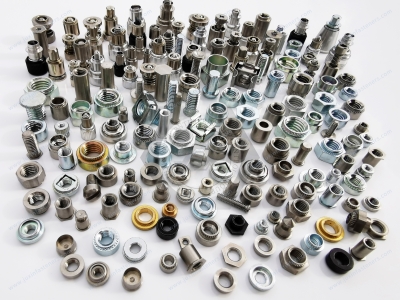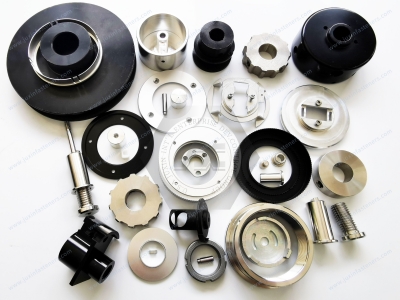Call Us
+86 136 6007 9809
Call Us
+86 136 6007 9809
Jan. 14, 2024
Pressure-riveted fasteners have industrial solutions in metal panels.
Many structural design metal panel connection occasions require the installation of other parts or components on the sheet metal parts. For example, buttons, switches, or other electronic devices may be mounted on metal panels, which may be connected to metal panels that cannot be connected to metal panels. One of the most common techniques used to make mounting connections more accessible and more reliable is the riveting technique.
The principle is to press in the pre-positioned holes in the sheet metal using a presser tooth, which is generally smaller than the diameter of the rivet nut's presser tooth, and then force the rivet nut's teeth into the sheet metal to create a plastic deformation of the periphery of the holes, which then pushes the deformed material into the guiding grooves and creates a locking effect—quality control of the riveting process.
Press-Fit Threaded Standoffs with Closed End: Also known as captive standoffs, a recess under the hex clinches the panel for a firm hold that won't push, pull, or twist out. When mounted, the hex sits flush with the surface, and the closed end creates a neat, finished appearance. Use a lever press to install.
18-8 stainless steel standoffs have good corrosion resistance and may be mildly magnetic.
Zinc-plated steel standoffs have some corrosion resistance.
Press-Fit Threaded Standoffs with Open End: A recess under the hex clinches a panel for a firm hold that won't push, pull, or twist out. When mounted with a lever press, the hex sits flush with the surface, and the open end creates a through hole. These are also known as captive standoffs.
Splined Press-Fit Threaded Standoffs with Open End: Also known as captive standoffs, the splines on these bite into a panel for a permanent hold, and the open end creates a through hole. They have good corrosion resistance and may be mildly magnetic. Use a lever press to install.
1. Contents of riveting work: riveting nuts, screws, studs, customized riveting parts (guide pins, positioning support pillars, etc.), electrostatic hand bowls, riveting wrenches, etc.
2. The materials and specifications of the riveted parts must be consistent with the drawings, and the wrong specifications must not be pressed;
3. Before riveting, we must promptly confirm that the external markings of riveted parts used on the production line and the physical parts (material and specifications) in the bag meet the drawing requirements and that materials are not mixed in the bag.
4. After riveting, random samples of the materials, specifications, and threads of riveted parts are selected and checked to ensure that they meet the drawings' requirements and that the rivets are free of omissions, mistakes, wrong positions, or mix-ups.
5. After riveting, the riveted parts shall not be deformed around raised or depressed areas, and there should be no obvious surface treatment that can't cover the imprint or mold mark.
6. After riveting, the riveted parts shall not be tilted, loosened, or dislodged and must be tested for firmness; its push/pull strength and strength must be to the specifications of the riveted parts of the PEM requirements.
7. After riveting, the threads of riveted parts must be qualified through the indicator gauge.
8. For riveted parts closer to the edge of the product or the periphery of the hole, after riveting, the edge of the product or the periphery of the hole will be deformed significantly; according to the deformation, the rise of the material to take appropriate measures (such as calibration, or grinding) to achieve the drawing size, appearance requirements.
9. Pressure riveting shall not appear after pressure distortion and pressure bias, and the thread and its corresponding hole must be ensured to be in the exact center.
10. For the bending edge or mold forming edge of the riveted parts closer to the focus, especially the thread, the appearance (deformation) to focus on testing.
11. The number of riveted studs and screws in a single product is relatively large, and some products are riveted with unique fixtures and special inspection tools are required to check for defects such as leakage or mis-pressing;
12. After the riveting process, it is necessary to check whether the surface degree is within the range. If it exceeds the standard, it must be transferred to a clamp for calibration.


Stainless Steel Aligning Press-Fit Nuts for Sheet Metal: These nuts have good chemical resistance and may be mildly magnetic. They have threads that float within the body, so you can install a bolt at a slight angle to align off-center parts. Knurls on the bottom of the nut hold them firmly in place. Press them into a drilled or punched hole with an installation tool or an arbor press. Installation requires access to both sides of the panel.
Metric Stainless Steel Press-Fit Nuts for Soft Metal and Plastic: Made from 18-8 stainless steel, these nuts have good chemical resistance and may be mildly magnetic. Also known as broach-style captive nuts, they are pressed into a drilled or punched hole in plastic and soft metal with an arbor press or similar pressure tool. Installation requires access to both sides of the panel. Knurls on the bottom of the nut hold them firmly in place.
Please get in touch with me if you want high-quality, Metric Stainless Steel Press-Fit Nuts for Soft Metal and Plastic fasteners or technical support for structural design. Thanks.Email:adelajonly@gmail.com
Website: https://www.juxinfasteners.com
Contact Us
Tel.:
+86 020 8621 0320
+86 020 3121 6067
Technical Support:
Navigation
SEND INQUIREY